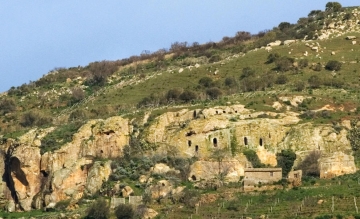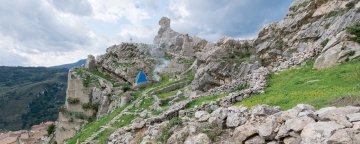Sito Archeologico Ambientale Monte d'Oro
Sito Archeologico Ambientale Monte d'Oro
On top of Monte d'Oro, in Croce county, about one km away from the present town, are located the ruins of the ancient Arab village of Qal'at as-sirat. On the northern part of the summit, on a platform 703 mt high, rise an ancient medieval village, still visible thanks to the presence of many ruins (houses, fortification walls, watchtowers and a structure similar to a castle). In this site, human presence is certified since classical age, as proved by some finds (mostly ceramics) attributable to roman-greek age. A permanent human settlement can be traced back only to the middle ages, under the Arab domination. In the 12th century (1130-1131) the village was destroyed and abandoned. The town center was partially inhabited until the subsequent century, when it was completely abandoned. In 1181 the town was already called villa vetus (old town in latin). During modern age (XVI-XVII century), the ancient Monte d'Oro settlement was identified by the Sicilian historians in those times as some greek-roman towns (Paropo, Alesa). In 1972 in the site took place a short excavation campaign, lead by Western Sicily Superintendence of Archeological Heritage: a good quantity of finds have been unearthed, such as coins from Swabian age (XIII century), an early medieval fibula, a lucerne and a significant amount of rough ceramics both for dining and for preserving. These finds were moved to Antonio Salinas from Palermo Archeological museum.
From the geological point of view, the Monte d'Oro is constituted by rocks of "Crisanti formation", which includes an alternation of marl, siliceous shales, radiolarites, calciruditi, limestones and calcareous sedimentary breccias. Structurally the relief is characterized by a pack of inclined layers towards northeast and by a fault system that dismember it in blocks showing the sedimented calcareous bodies of "Crisanti formation" among the clay rocks of the "Numidian flysch". The limestone shows the typical signs epigean karst processes such as sinkholes, furrows, karren and underground structures like caves and cavities. The vegetation, that still resists the frequent fires, can be distinguished in three categories: very degraded macchia and forests (Quercetea ilicis); high and medium Elevations cliffs; abandoned cultivations (medium and high Elevation grasslands, scrublands and shrubs ). The fauna, includes not only the most of vertebrates in Madonie, but is distinguished by the presence of birds such as buzzards, kestrels, lesser kestrel, the Sicilian rock partridge and the rare Egyptian vulture.
On Monte d'Oro walls can be practiced athletic and classic rock climbing.









